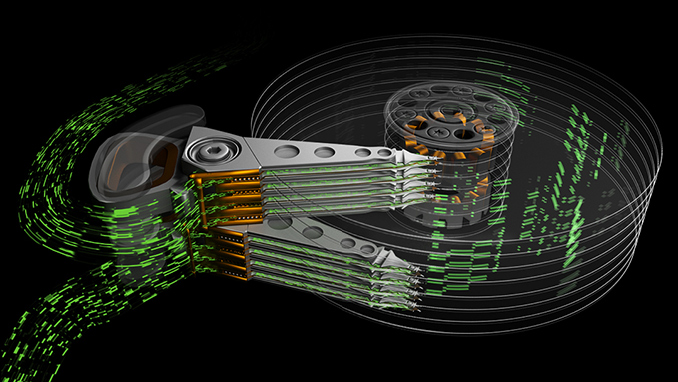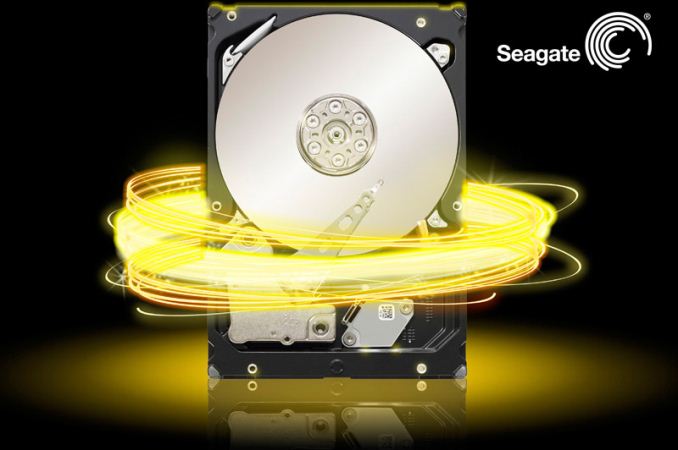Seagate’s Multi Actuator Technology to Address HDD IOPS Woes
by Anton Shilov on December 29, 2017 12:01 PM EST
Seagate introduced its new Multi-Actuator Technology (MAT) for hard drives earlier this month. It promises to increase hard drive performance by using two or more sets of actuator arms that operate independently from a single pivot point. Seagate claims that next-gen HDDs will require higher performance to effectively take advantage of their increased capacities. It plans to use MAT in their datacenter hard drives going into pilot production in 2018.
To improve the performance of next-generation hard drives, Seagate proposes to install not one, but two (or more) sets of actuators into a single HDD. The actuators are to be equipped with their own arms/heads as well as magnets to position them, but will use one pivot. As a result, the actuators will be able to act completely independently, essentially creating parallelism within a single hard drive. With an architecture like this, IOPS performance will scale with the number of actuators. Aggregate read/write performance of hard drives will also increase, but since it will depend on many factors, it is too early to make predictions regarding throughput of next-gen HDDs. The additional components required for two independent actuator assemblies (and a considerably more sophisticated HDD controller) will make such hard drives more expensive to build when compared to today’s models. This could be one of the reasons why Seagate plans to use its Multi-Actuator Technology only for hard drives designed for datacentres, where hardware costs are not as crucial as performance and features.
The first-generation MAT-enabled HDDs are to use two actuators operating on a single pivot point (along with 8 platters and 16 heads), but going forward the number of actuators may grow. Seagate says that the host computer can “treat a single Dual Actuator drive as if it were two separate drives”, but stresses that logically the HDD will remain a single device with two access streams for communication, just like dual-port SAS drives do. Meanwhile, Dual Actuator HDDs will be able to use not only SAS, but also NVMe and SATA interfaces. In the best-case scenario, a hard drive with two actuators can double the random read/write performance and almost double the sequential read/write performance compared to today's hard drives. The sequential access case is a bit tricky, since the cylinder height gets halved with two actuators, and a lot depends on how the addresses are translated to the actual physical sectors.
The arrival of new magnetic recording technologies in the coming years will significantly increase capacities of hard drives for cloud/exascale datacenters to over 20 TB by 2020 and to 40 TB within the next five or seven years. The upcoming HDDs will increase their sequential read/write performance along with the increase of their areal densities, but when it comes to latencies and random read and write operations, things get more complicated. The current HDD architecture uses a single actuator that synchronously moves all the arms with read-write heads over the media together for reading and writing data. With such an architecture, the platters can only work on one request at a time. Meanwhile, the more data an HDD stores, the more requests it gets and the more time it spends seeking the right track/sector. If/when fulfilling a request takes too long, quality of service (a metric dear to datacenter operators) suffers. Today, the performance bottleneck is solved by using either NAND flash or multiple hard drives in parallel, effectively combining their performance for certain access traces. At some point, this approach may become inefficient due to power/complexity and other factors. Therefore, it is imperative that HDDs get faster in order to cope with tomorrow’s workloads.
Seagate says that the Multi-Actuator Technology is to be deployed on products in the near future, but does not disclose when exactly. As the company’s blog post on the matter mentions both MAT and HAMR, it is highly likely that commercial hard drives featuring HAMR due in late 2019 will also have two actuators on a single pivot. At the same time, it does not mean that the MAT is not going to find itself a place in products using conventional PMR.
Related Reading
- Western Digital Stuns Storage Industry with MAMR Breakthrough for Next-Gen HDDs
- Toshiba Announces 14 TB PMR MG07ACA HDD: 9 Platters, Helium-Filled, 260 MB/s
- Toshiba Commercializes SDK’s 9th Gen PMR, Tech Enables 14 TB PMR HDDs in 2018
- Western Digital Now Shipping 14 TB HDDs: HGST Ultrastar Hs14 with 1000 Gb/in2
- Western Digital Announces Ultrastar He12 12 TB and 14 TB HDDs
- Seagate Announces Enterprise Capacity 12 TB HDD: 2nd-Gen Helium-Filled Hard Drives
Source: Seagate











88 Comments
View All Comments
mode_13h - Tuesday, January 2, 2018 - link
Thanks for sharing your knowledge & expertise with us.I'm excited by MAMR. I have more faith in it than HAMR, but I'll keep an open mind and wait for some hard data.
cjl - Tuesday, January 2, 2018 - link
MAMR is very interesting. I was at Seagate rather than WD, and I haven't been in the industry for a while anyways, so I know more about HAMR than MAMR, but I'm definitely following the developments in both with some interest.ddriver - Sunday, December 31, 2017 - link
Not much of an outside the box thinker eh? Incapable of conceiving something you haven't already seen. Assuming the absurd necessity for a head for every track. It must really suck being you.My concept employs a head for every group of tracks, currently 1024, but the number can vary. Each head is a motionless actuator on its own, it consists of focusing coils and data access coils. It can instantaneously alter the shape of its magnetic field to concentrate it on a particular track in the group.
The head array itself is a bar that incorporates about 200 individual heads per inch. That bar is only 5 mm wide, so you can actually have multiple head arrays per platter surface, as much as you can fit. This allows to scale the design significantly higher than the already high estimates of my baseline design, which has only 2 heads per surface.
Granted, the actual latency cannot go below 0.1 msec since it is after all still a spinning disk, but the addition of head arrays scales up throughput and iops almost linearly. The design can easily scale well beyond what is necessary. Terabytes of throughput and millions of iops per second.
cjl - Sunday, December 31, 2017 - link
I suspect you don't know just how much effort has gone into making the write magnetic field as focused as it is - I'd be very surprised if you could get tracks anywhere close to as narrow as is common today with your "concept". This is even shown by the fact that your undemonstrated "concept" has 200 heads per inch at 1024 tracks per head, when modern hard drives are running approximately double that density (~400ktpi). That having been said, I don't think you could even achieve 200ktpi with your focusing coil concept, since you'd get too much adjacent track interference every time you wanted to write.Also, your latency is still ignoring rotational latency. If your baseline design has 2 head arrays per surface, that actually makes my last estimate generous by a factor of 2 - you're looking at typical access times of ~4ms, and worst case around 8ms. This is assuming zero latency on the head array, and comes purely from the rotational latency of a 4000RPM (your spec) disk with 2 read locations spaced 180 degrees apart. To achieve your 0.1ms figure, you'll need around a hundred head arrays spaced equally around the disk at 4000RPM, or alternatively, you'll need one head array and a 300krpm disk.
mode_13h - Sunday, December 31, 2017 - link
You mistakenly assume he cares about the practical details of actually implementing it. In fact, he just needs to develop the idea far enough to feed his ego.lightningz71 - Sunday, December 31, 2017 - link
I've wondered about this very concept for years. I think that we can look for the peak of this technology to be effectively:A 3.5" hard drive external form factor.
A 2.5" hard drive platter assembly spinning at 15,000 RPM
4 pivots arrayed in a square around the platters
2 independent actuators per pivot.
That would be about the pinnacle of what you're going to achieve in throughput and IOPs for a mechanical hard drive. To handle all of that, you're going to need a significant buffer on the drive itself, something in the order of 512MB. You're also going to likely need multiple SATA interfaces as the interface will begin to restrict the number of ops that you can get to the drive. In the enterprise space, SAS-4 could handle all of this, but SATA-3 would likely hit some severe limitations when you're pushing this configuration hard.
In the 2.5" external form factor, you might be able to work in a pair of pivots and 4 total actuators. Might be nice for a laptop that needs both high capacity and high performance. Maybe good for high density servers too.
mode_13h - Sunday, December 31, 2017 - link
So, you're saying like 4 heads for each platter? I'm pretty sure I've seen old designs that had two. Perhaps when HDDs become dense enough, it'll be worthwhile to increase the number of heads.cjl - Tuesday, January 2, 2018 - link
I suspect we won't ever see 15krpm come back - you sacrifice too much in density capability, and the costs are just too high. We may see 10krpm continue to survive for quite a while, and the 2.5" platter in a 3.5" enclosure is pretty much how existing high-RPM HDD designs already work, but I tend to think that the majority of the HDD industry will stick with 7200RPM for now, since that's where the price/capacity/speed tradeoff seems to work best. This is especially true if they go to multiple actuators spaced around the disk, since that cuts rotational latency in half (giving a 7200RPM drive similar rotational latency to a single actuator 15k).